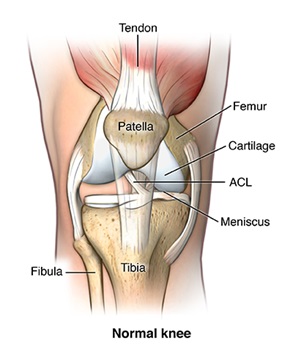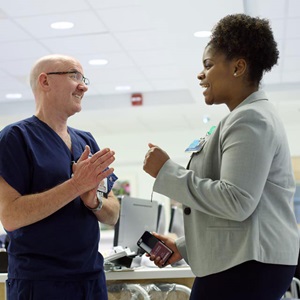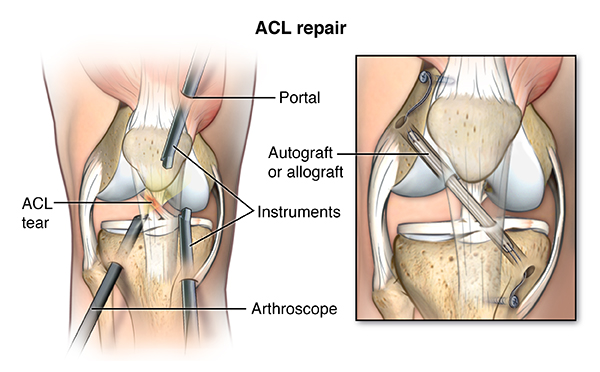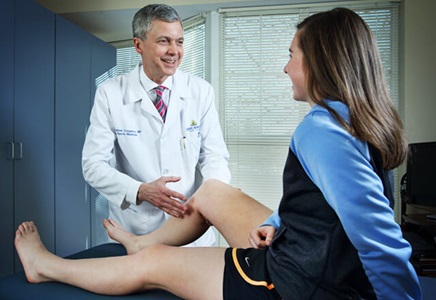How Does A Surgeon Repair Torn Ligaments In An Ankle
Articulatio genus Ligament Repair
What is knee ligament repair?
Ligaments are bands of tough, elastic connective tissue that environs a joint to give support and limit the joint's motion.
When ligaments are damaged, the knee joint may go unstable. Ligament damage often happens from a sports injury. A torn ligament severely limits knee movement. This results in the disability to pin, plow, or twist the leg. Surgery is a choice to repair a torn ligament if other medical treatment is not constructive.

There are 4 major ligaments in the human knee. The ligaments in the knee joint connect the femur (thighbone) to the tibia (shin bone), and include the following:
- Anterior cruciate ligament (ACL). The ligament, located in the center of the knee, that controls rotation and forward motility of the tibia (shin os).
- Posterior cruciate ligament (PCL). The ligament, located in the center of the articulatio genus, that controls backward movement of the tibia (shin bone).
- Medial collateral ligament (MCL). The ligament that gives stability to the inner knee.
- Lateral collateral ligament (LCL). The ligament that gives stability to the outer knee.

ACL Tears in Female Athletes: Q&A with a Sports Medicine Adept
Sports injury prevention isn't a i-stop shop, specially for injuries like ACL tears, which are four to eight times more mutual amongst women than men. Observe ways for women to assistance foreclose this common injury.
Why might I need a knee ligament repair?
The anterior cruciate ligament (ACL) is located toward the front end of the articulatio genus. It is the most common ligament to be injured. The ACL is often stretched and/or torn during a sudden twisting movement (when the feet stay planted one way, but the knees turn the other way). Skiing, basketball, and football are sports that accept a higher risk of ACL injuries.
The posterior cruciate ligament (PCL) is located toward the dorsum of the articulatio genus. It is also a mutual knee ligament to be injured. Nonetheless, the PCL injury usually happens with sudden, direct affect, such as in a auto accident or during a football tackle.
The medial collateral ligament (MCL) is located on the inner side of the knee. It is injured more often than the lateral collateral ligament (LCL), which is on the outer side of the articulatio genus. Stretch and tear injuries to the collateral ligaments are usually caused past a blow to the outer side of the genu, such every bit when playing hockey or football.
Early medical handling for knee ligament injury may include:
-
Residual
-
Ice pack application (to reduce swelling that happens within hours of the injury)
-
Compression (from an rubberband bandage or brace)
-
Elevation
-
Pain relievers
A human knee ligament tear may be treated with the following:
-
Muscle-strengthening exercises
-
Protective knee joint caryatid (for use during exercise)
-
Activity limitations
Knee joint ligament repair is a treatment for a complete tear of a knee ligament that results in instability in the articulatio genus. People with a torn knee ligament may exist unable to practise normal activities that involve twisting or turning at the knee. The knee may buckle or "give-mode." If medical treatments are not satisfactory, ligament repair surgery may exist an effective treatment.
The surgery to correct a torn knee ligament involves replacing the ligament with a piece of healthy tendon. A tendon from the kneecap or hamstring, for instance, is grafted into place to hold the knee joint joint together. The tendon graft may come up from the person (autograft) or from an organ donor (allograft).
There may exist other reasons for your healthcare provider to recommend a articulatio genus ligament repair.
ACL Injuries | Q&A with Dr. Jay Lee
What are the risks of knee joint ligament repair?
As with whatever surgical process, complications can happen. Some possible complications may include the following:
-
Bleeding
-
Infection
-
Blood clots in the legs or lungs
Some people may experience pain, limited range of motility in the knee joint, and occasional swelling in the knee after surgical ligament repair. Others have increased move in the knee articulation equally the graft stretches over time.
In that location may be other risks depending on your specific medical condition. Be sure to discuss whatsoever concerns with your healthcare provider earlier the procedure.
Preparing for Knee Replacement Surgery | Q&A with Savya Thakkar, One thousand.D.
Orthopaedic hip and knee surgeon Savya Thakkar describes how to prepare for your knee replacement surgery, the procedure, recovery and life with an implant.
How practise I become ready for a knee ligament repair?
-
Your healthcare provider will explicate the process to you and offering yous the take a chance to enquire any questions that you might have well-nigh the process.
-
You lot volition exist asked to sign a consent form that gives your permission to practice the process. Read the grade carefully and ask questions if something is non clear.
-
In improver to a complete medical history, your healthcare provider may perform a complete physical exam to ensure you are in practiced health before undergoing the procedure. You lot may undergo blood tests or other diagnostic tests.
-
Tell your healthcare provider if yous are sensitive to or are allergic to any medicines, latex, tape, and anesthetic agents (local and general).
-
Tell your healthcare provider of all medicines (prescribed and over-the-counter) and herbal supplements that you are taking.
-
Tell your healthcare provider if you lot have a history of bleeding disorders or if you are taking any anticoagulant (blood-thinning) medicines, aspirin, or other medicines that affect claret clotting. It may be necessary for you lot to stop these medicines earlier the procedure.
-
If you are significant or doubtable that you are meaning, you should notify your healthcare provider.
-
Yous will be asked to fast for viii hours earlier the procedure, generally after midnight.
-
You may receive a sedative prior to the procedure to help you relax. Considering the sedative may make you lot drowsy, you will need to arrange for some to drive you home.
-
Y'all may run into with a concrete therapist prior to your surgery to talk over rehabilitation.
-
Arrange for someone to assistance effectually the house for a calendar week or two later you lot are discharged from the hospital.
-
Based on your medical condition, your healthcare provider may request other specific preparation.

Your thoughts matter to us. Join our community today.
Johns Hopkins Medicine Virtual Advisors (Virtual Advisors) is a group of individuals who share their insights about the Johns Hopkins care feel. One to 2 times per month, Virtual Advisors receive a link to brusque, interactive surveys. All responses are confidential.
What happens during a knee joint ligament repair?
Knee ligament repair may exist performed on an outpatient basis or rarely as part of your stay in a hospital. Procedures may vary depending on your condition and your healthcare provider'southward practices.
Knee joint ligament repair may exist performed while y'all are comatose nether general anesthesia, or while you lot are awake under spinal anesthesia. If spinal anesthesia is used, y'all will take no feeling from your waist downward. Your healthcare provider will talk over this with you in accelerate.

Generally, knee ligament repair surgery follows this process:
-
You will be asked to remove clothing and will exist given a gown to article of clothing.
-
An intravenous (IV) line may be started in your arm or hand.
-
Yous volition be positioned on the operating table.
-
The anesthesiologist volition continuously monitor your heart rate, blood pressure, breathing, and blood oxygen level during the surgery.
-
The pare over the surgical site volition be cleansed with an antiseptic solution.
-
The healthcare provider will make several pocket-sized incisions in the knee area.
-
The healthcare provider will perform the surgery using an arthroscope (a small tube-shaped instrument that is inserted into a articulation). The healthcare provider may reattach the torn ligament or reconstruct the torn ligament by using a portion (graft) of the patellar tendon (that connects the kneecap to the tibia), the hamstring tendon (from the dorsum of the thigh), or other autografts. The tendon graft may come up from the person (autograft) or from an organ donor (allograft).
-
The healthcare provider will drill small holes in the tibia and femur where the torn ligament was fastened.
-
The healthcare provider will thread the graft through the holes and attach information technology with surgical staples, screws, or other means. Bone eventually grows effectually the graft.
-
The incision volition exist closed with stitches or surgical staples.
-
A sterile bandage or dressing will be applied.

Tailor-Made Treatment for ACL Tears
An individual approach to repairing ACL damage works all-time for Dr. Andrew Cosgarea'southward diverse patient population. Once he knows how agile a patient wants to exist, he tailors the operation and graft for that patient'due south reconstruction.
What happens after a human knee ligament repair?
After the surgery yous volition be taken to the recovery room for ascertainment. Your recovery process volition vary depending on the type of anesthesia that is given. In one case your blood pressure, pulse, and animate are stable and you are alarm, you will be taken to your hospital room or discharged to your dwelling house. Genu ligament repair is usually done on an outpatient basis.
Y'all may be given crutches and a knee joint immobilizer before yous go abode.
In one case you are abode, it is important to keep the surgical surface area clean and dry. Your healthcare provider will give you lot specific bathing instructions. The stitches or surgical staples will be removed during a follow-up part visit.
Take a pain reliever for soreness every bit recommended by your healthcare provider. Aspirin or certain other pain medicines may increase the chance of bleeding. Be certain to take merely recommended medicines.
To help reduce swelling, yous may be asked to elevate your leg and apply an ice bag to the knee several times per day for the showtime few days. Your healthcare provider will arrange for an exercise program to help yous regain musculus strength, stability, and range of motion.
Notify your healthcare provider to report whatever of the following:
-
Fever or chills
-
Redness, swelling, bleeding, or other drainage from the incision site
-
Increased pain around the incision site
Yous may resume your normal diet unless your healthcare provider advises you differently.
Considering of the limited mobility, it may exist difficult for a few weeks to resume your normal daily activities. Y'all may need someone at home to assist you. Yous should non drive until your healthcare provider tells you to. Other activity restrictions may apply. Full recovery from the surgery and rehabilitation may accept several months.
Your healthcare provider may give you additional or alternating instructions later on the procedure, depending on your detail situation.
How Does A Surgeon Repair Torn Ligaments In An Ankle,
Source: https://www.hopkinsmedicine.org/health/treatment-tests-and-therapies/knee-ligament-repair
Posted by: dunawayselse1995.blogspot.com


0 Response to "How Does A Surgeon Repair Torn Ligaments In An Ankle"
Post a Comment